Get free scan and check if your device is infected.
Remove it nowTo use full-featured product, you have to purchase a license for Combo Cleaner. Seven days free trial available. Combo Cleaner is owned and operated by RCS LT, the parent company of PCRisk.com.
What kind of malware is RMC?
RMC is a stealer-type malware based on the Electron framework. The potential origin of this malicious program is the sale of Leet stealer's source code in April 2025, as there is some evidence that the code was used when building RMC. This malware, as well as Leet and Sniffer stealers, have been spread through sophisticated campaigns using lures centered on video games.
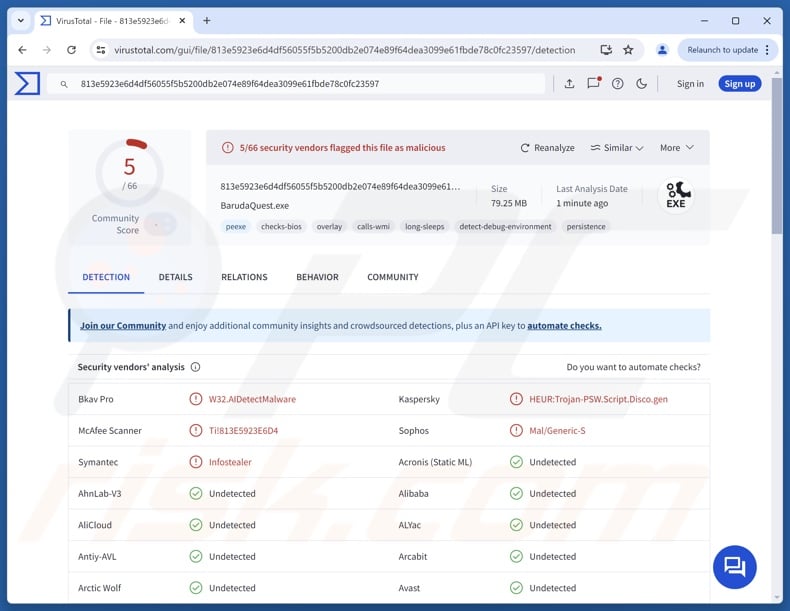
RMC malware overview
RMC is designed to steal sensitive information from systems, and due to this behavior, it is classed as a stealer. This malware has anti-analysis and anti-detection mechanisms, such as checking for sandbox environments through an exclusion list containing operating systems, GPUs (Graphics Processing Unit), hostnames, usernames, and running processes.
RMC stealer can extract data from various browsers, including Google Chrome, Brave, Microsoft Edge, Opera, Vivaldi, Yandex, and Chromium. Information of interest includes browser cookies, usernames/passwords, and personally identifiable data.
Other targeted programs are messengers (Discord, BetterDiscord, WhatsApp, Telegram) and gaming-related software (Steam, Growtopia, Minecraft, Epic Games). The stealer can extract extensive information from Discord, which allows the attackers to access the user's servers, friend lists, messages, and other personal data.
Additionally, RMC can cause chain infections. Theoretically, programs capable of downloading/installing additional payloads can infiltrate any type of malware into systems (e.g., trojans, ransomware, cryptocurrency miners, etc.). However, these programs tend to work within certain limitations or specifications in practice.
It is pertinent to mention that an older variant of Leet, the stealer likely used as the basis for the RMC stealer, has more capabilities – i.e., stealing cryptocurrency wallets, executing PowerShell commands, exhibiting remote desktop functionalities, etc. It is likewise worth mentioning that malware developers often improve upon their software/methodologies. Therefore, possible future iterations of RMC could have additional/different functions and features.
In summary, the presence of software like the RMC stealer on devices can lead to multiple system infections, severe privacy issues, financial losses, and identity theft.
| Name | RMC malware |
| Threat Type | Trojan, stealer, password-stealing virus. |
| Detection Names | Bkav Pro (W32.AIDetectMalware), Kaspersky (HEUR:Trojan-PSW.Script.Disco.gen), McAfee Scanner (Ti!813E5923E6D4), Sophos (Mal/Generic-S), Symantec (Infostealer), Full List Of Detections (VirusTotal) |
| Symptoms | Trojans are designed to stealthily infiltrate the victim's computer and remain silent, and thus no particular symptoms are clearly visible on an infected machine. |
| Distribution methods | Infected email attachments, malicious online advertisements, social engineering, software 'cracks'. |
| Damage | Stolen passwords and banking information, identity theft, the victim's computer added to a botnet. |
| Malware Removal (Windows) |
To eliminate possible malware infections, scan your computer with legitimate antivirus software. Our security researchers recommend using Combo Cleaner. Download Combo CleanerTo use full-featured product, you have to purchase a license for Combo Cleaner. 7 days free trial available. Combo Cleaner is owned and operated by RCS LT, the parent company of PCRisk.com. |
Stealer-type malware examples
We have written about numerous malicious programs; SHUYAL, Myth, and Scruffy are merely a couple of our latest articles on stealers. These programs can be incredibly versatile or target only specific pieces of data.
However, regardless of what (if any) information that malware seeks to exfiltrate – its presence on a system remains a threat to device integrity and user safety. Therefore, all threats must be eliminated immediately upon detection.
How did RMC infiltrate my computer?
As mentioned in the introduction, gaming-themed campaigns have been used to proliferate the RMC, Leet, and Sniffer stealers. The malware arrived onto systems as video games. Some of the games were fake and had dedicated sites and YouTube channels, creating an impression of legitimacy.
The webpages relied on branding and artwork of real games, e.g., "WarHeirs" stole from The Braves, "Dire Talon" – Project Feline, "Warstorm Fire" – Crossfire: Sierra Squad, and "Baruda Quest" – Club Cooee. Most of these "official" game websites were in Portuguese, and a significant number of victims were located in Brazil. Numerous infections were also detected in the US and Turkey. These supposed video games were promoted on Discord.
RMC stealer's executables had names relating to Steam, setups, and indie games. As of the time of writing, some of the legitimate titles (e.g., Eden, Rooted, Catly) used in the filenames are listed on Steam but have yet to be released. This does not negatively affect the proliferation of the malware, as Steam has an early access program.
It must be mentioned that RMC could be spread by relying on other methods. Phishing and social engineering are standard in malware proliferation. Malicious programs are often disguised as or bundled with regular content.
Virulent files come in various formats, e.g., executables (.exe, .run, etc.), archives (ZIP, RAR, etc.), documents (Microsoft Office, Microsoft OneNote, PDF, etc.), JavaScript, and so on. Merely opening a malicious file can be enough to trigger the system infection chain.
Malware is predominantly distributed via trojans (backdoors/loaders), drive-by (stealthy/deceptive) downloads, untrustworthy download channels (e.g., unofficial and free file-hosting sites, Peer-to-Peer sharing networks, etc.), spam emails/messages, malvertising, online scams, pirated programs/media, illegal software activation ("cracking") tools, and fake updates.
Some malicious programs can self-proliferate through local networks and removable storage devices (e.g., USB flash drives, external hard drives, etc.).
How to avoid installation of malware?
We highly recommend researching software and downloading it only from official/verified sources. All programs must be activated and updated using legitimate functions/tools, as those acquired from third-parties can contain malware.
Another recommendation is to be vigilant when browsing, since fraudulent and dangerous online content usually appears genuine and innocuous. Incoming emails and other messages must be approached with care. Attachments or links found in suspicious communications must not be opened, as they can be virulent.
It is paramount for device/user safety to have a reputable antivirus installed and kept updated. This software must be used to perform regular system scans and to remove threats and issues. If you believe that your computer is already infected, we recommend running a scan with Combo Cleaner Antivirus for Windows to automatically eliminate infiltrated malware.
Screenshot of fake game websites promoting the RMC stealer (image source Acronis):
Instant automatic malware removal:
Manual threat removal might be a lengthy and complicated process that requires advanced IT skills. Combo Cleaner is a professional automatic malware removal tool that is recommended to get rid of malware. Download it by clicking the button below:
DOWNLOAD Combo CleanerBy downloading any software listed on this website you agree to our Privacy Policy and Terms of Use. To use full-featured product, you have to purchase a license for Combo Cleaner. 7 days free trial available. Combo Cleaner is owned and operated by RCS LT, the parent company of PCRisk.com.
Quick menu:
How to remove malware manually?
Manual malware removal is a complicated task - usually it is best to allow antivirus or anti-malware programs to do this automatically. To remove this malware we recommend using Combo Cleaner Antivirus for Windows.
If you wish to remove malware manually, the first step is to identify the name of the malware that you are trying to remove. Here is an example of a suspicious program running on a user's computer:
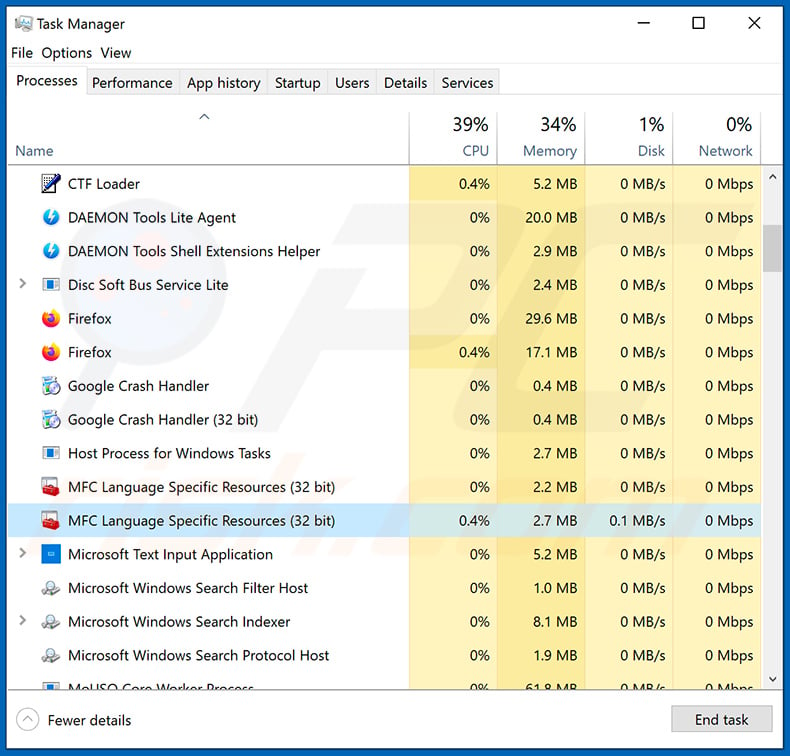
If you checked the list of programs running on your computer, for example, using task manager, and identified a program that looks suspicious, you should continue with these steps:
 Download a program called Autoruns. This program shows auto-start applications, Registry, and file system locations:
Download a program called Autoruns. This program shows auto-start applications, Registry, and file system locations:
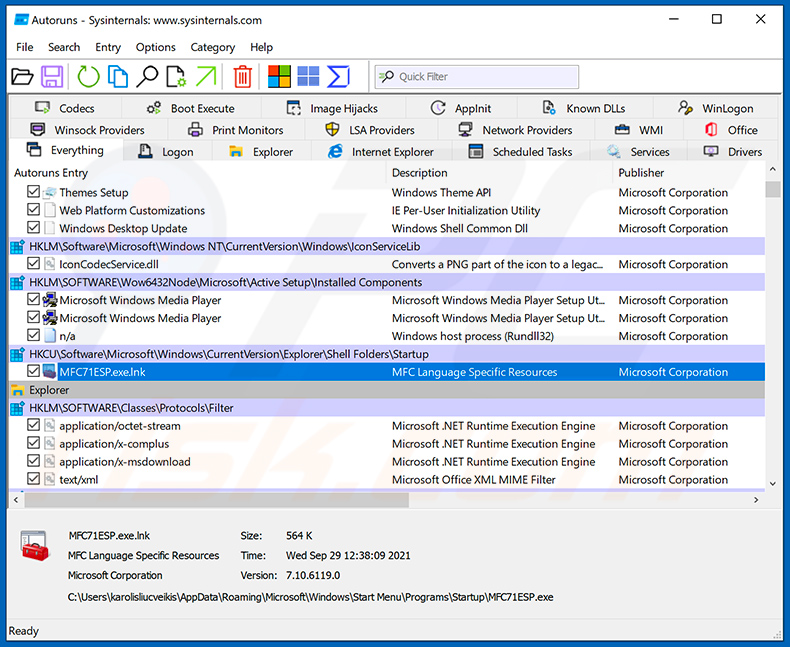
 Restart your computer into Safe Mode:
Restart your computer into Safe Mode:
Windows XP and Windows 7 users: Start your computer in Safe Mode. Click Start, click Shut Down, click Restart, click OK. During your computer start process, press the F8 key on your keyboard multiple times until you see the Windows Advanced Option menu, and then select Safe Mode with Networking from the list.
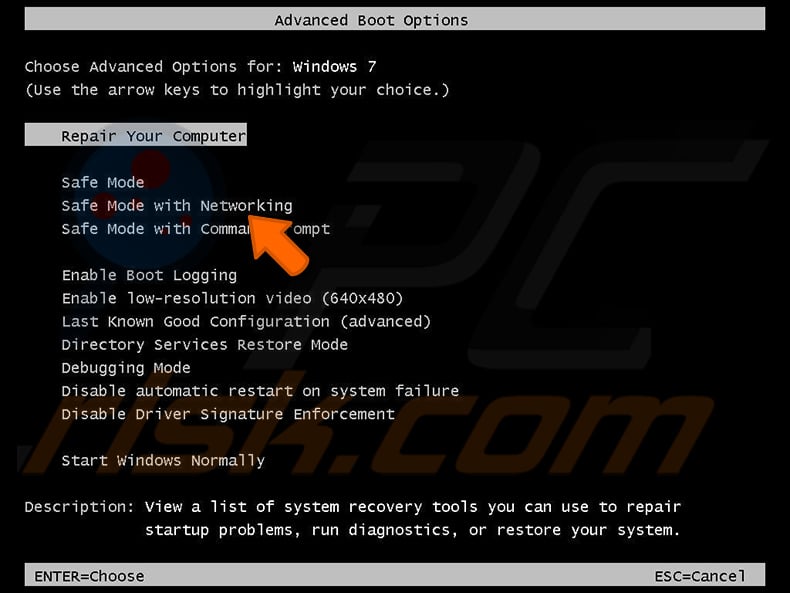
Video showing how to start Windows 7 in "Safe Mode with Networking":
Windows 8 users: Start Windows 8 is Safe Mode with Networking - Go to Windows 8 Start Screen, type Advanced, in the search results select Settings. Click Advanced startup options, in the opened "General PC Settings" window, select Advanced startup.
Click the "Restart now" button. Your computer will now restart into the "Advanced Startup options menu". Click the "Troubleshoot" button, and then click the "Advanced options" button. In the advanced option screen, click "Startup settings".
Click the "Restart" button. Your PC will restart into the Startup Settings screen. Press F5 to boot in Safe Mode with Networking.
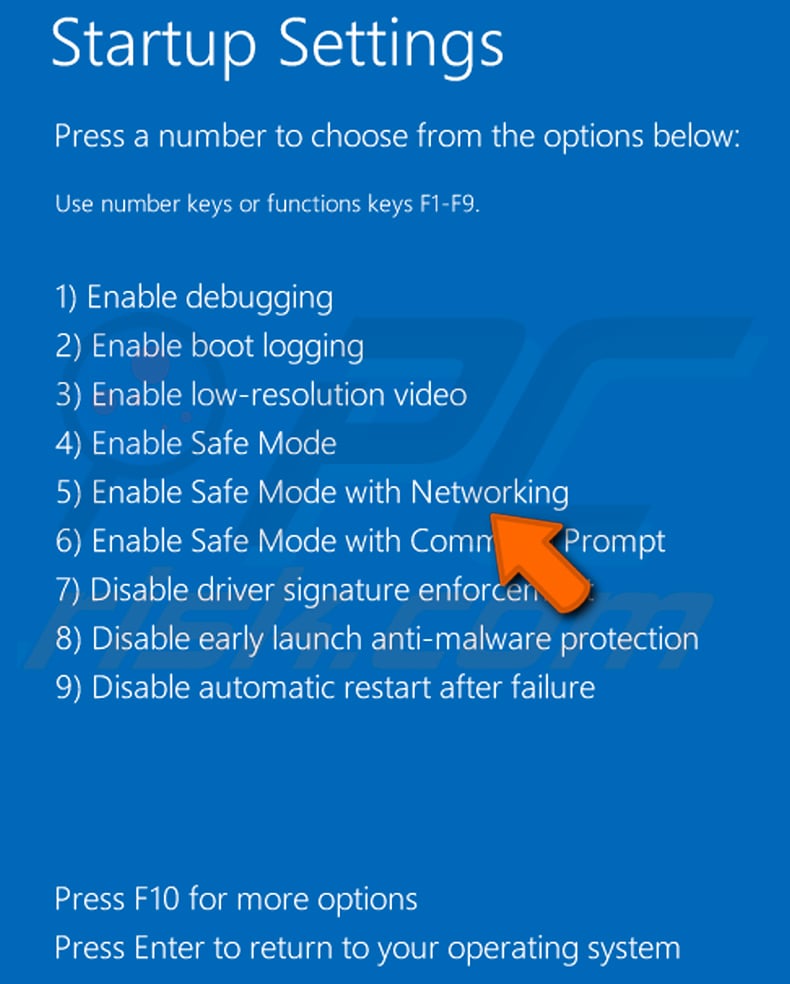
Video showing how to start Windows 8 in "Safe Mode with Networking":
Windows 10 users: Click the Windows logo and select the Power icon. In the opened menu click "Restart" while holding "Shift" button on your keyboard. In the "choose an option" window click on the "Troubleshoot", next select "Advanced options".
In the advanced options menu select "Startup Settings" and click on the "Restart" button. In the following window you should click the "F5" button on your keyboard. This will restart your operating system in safe mode with networking.
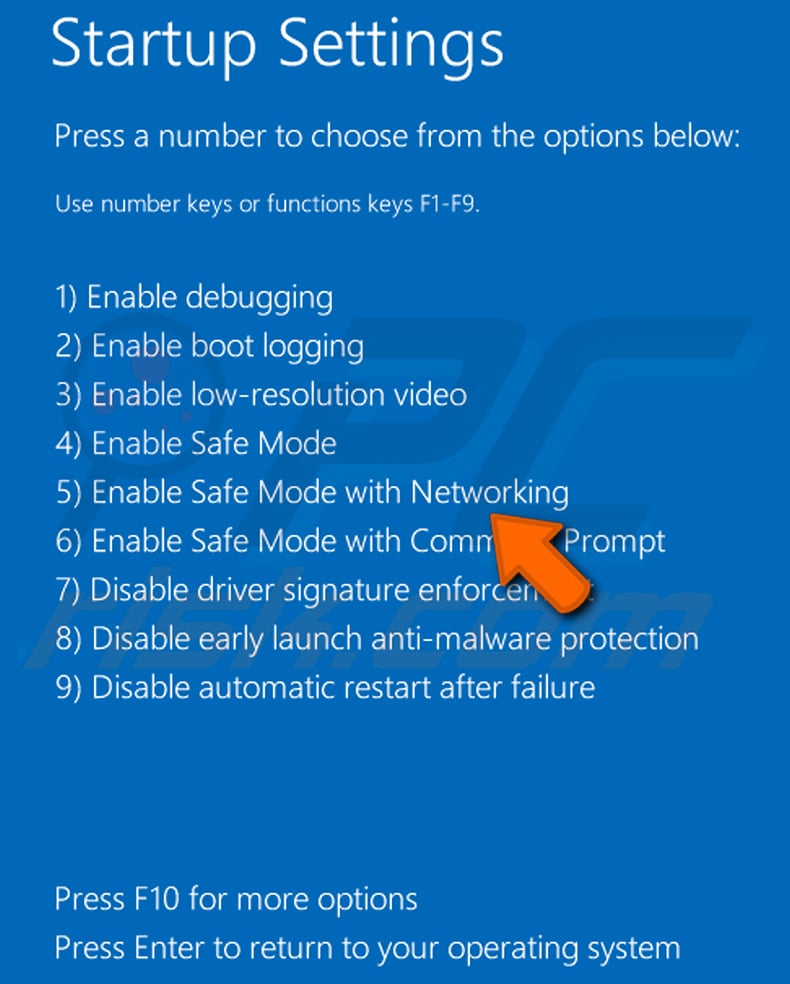
Video showing how to start Windows 10 in "Safe Mode with Networking":
 Extract the downloaded archive and run the Autoruns.exe file.
Extract the downloaded archive and run the Autoruns.exe file.
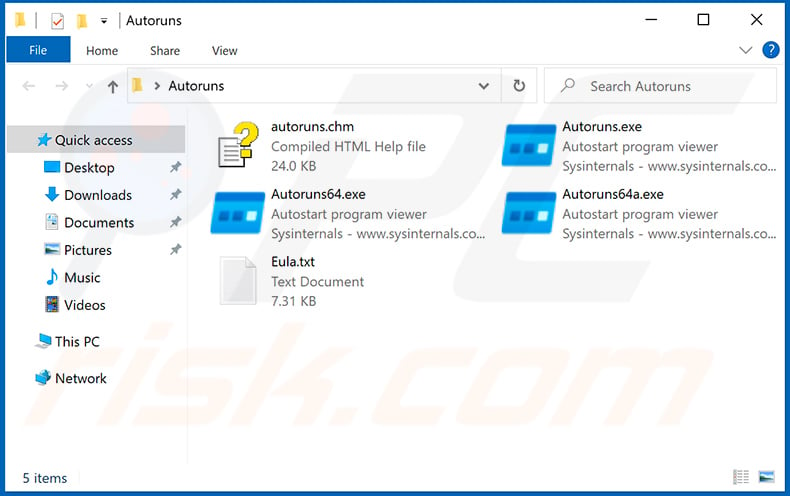
 In the Autoruns application, click "Options" at the top and uncheck "Hide Empty Locations" and "Hide Windows Entries" options. After this procedure, click the "Refresh" icon.
In the Autoruns application, click "Options" at the top and uncheck "Hide Empty Locations" and "Hide Windows Entries" options. After this procedure, click the "Refresh" icon.
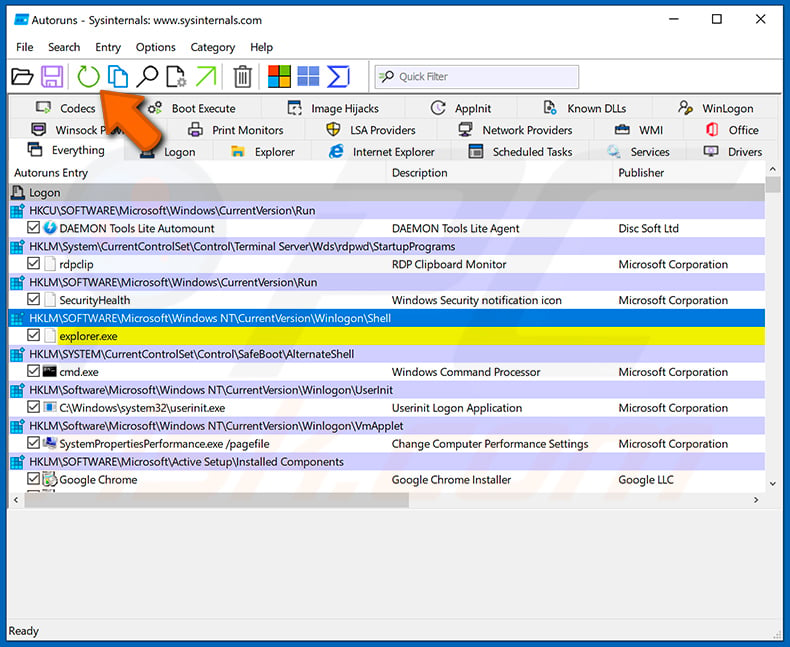
 Check the list provided by the Autoruns application and locate the malware file that you want to eliminate.
Check the list provided by the Autoruns application and locate the malware file that you want to eliminate.
You should write down its full path and name. Note that some malware hides process names under legitimate Windows process names. At this stage, it is very important to avoid removing system files. After you locate the suspicious program you wish to remove, right click your mouse over its name and choose "Delete".
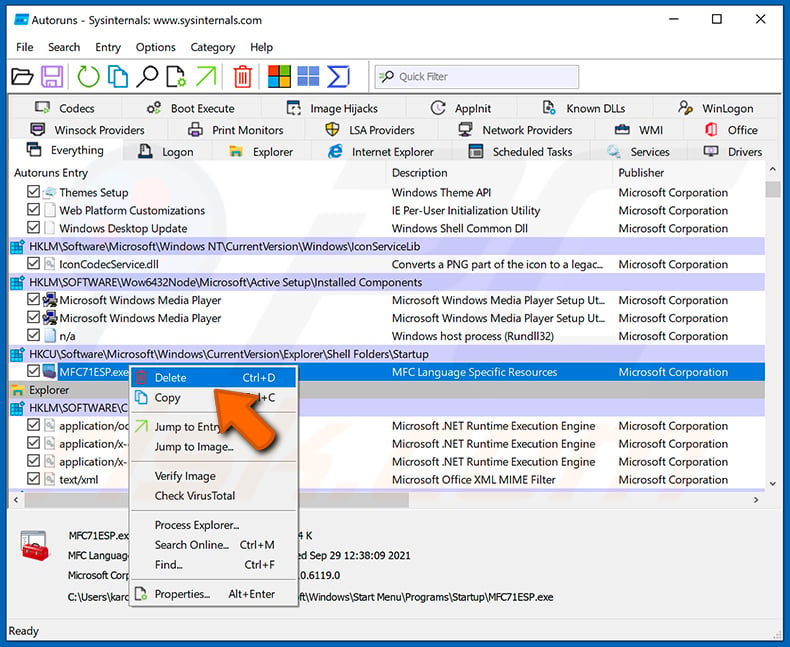
After removing the malware through the Autoruns application (this ensures that the malware will not run automatically on the next system startup), you should search for the malware name on your computer. Be sure to enable hidden files and folders before proceeding. If you find the filename of the malware, be sure to remove it.
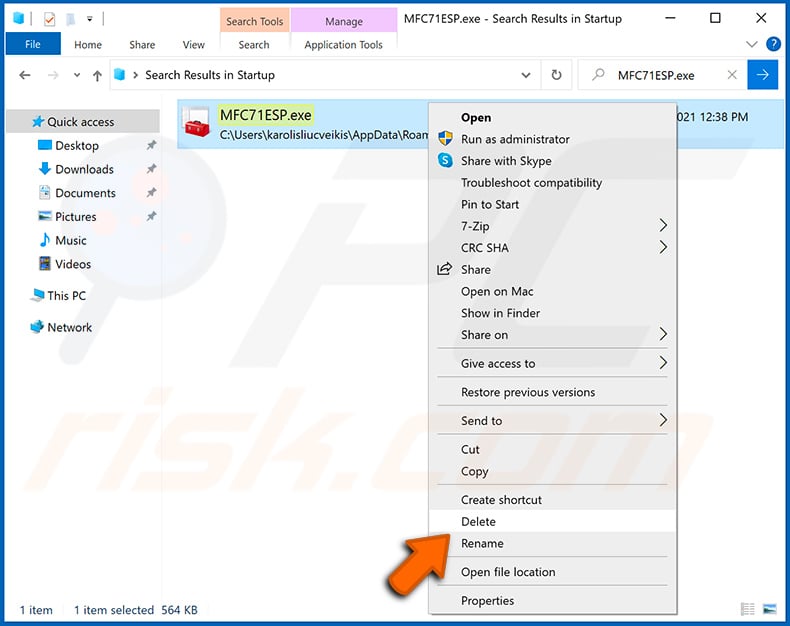
Reboot your computer in normal mode. Following these steps should remove any malware from your computer. Note that manual threat removal requires advanced computer skills. If you do not have these skills, leave malware removal to antivirus and anti-malware programs.
These steps might not work with advanced malware infections. As always it is best to prevent infection than try to remove malware later. To keep your computer safe, install the latest operating system updates and use antivirus software. To be sure your computer is free of malware infections, we recommend scanning it with Combo Cleaner Antivirus for Windows.
Frequently Asked Questions (FAQ)
My computer is infected with RMC malware, should I format my storage device to get rid of it?
Most likely, no. Malware removal rarely necessitates such drastic measures.
What are the biggest issues that RMC malware can cause?
The dangers posed by an infection depend on the malicious program's abilities and the cyber criminals' modus operandi. RMC is a stealer capable of extracting sensitive data and causing chain infections. Hence, its presence on a device may result in multiple system infections, serious privacy issues, financial losses, and identity theft.
What is the purpose of RMC malware?
The most common motivation for infections is financial gain. However, attackers can also use malware to amuse themselves, realize personal grudges, disrupt processes (e.g., websites, services, companies, etc.), engage in hacktivism, and launch politically/geopolitically motivated attacks.
How did RMC malware infiltrate my computer?
RMC has been distributed under the guise of video games, which had dedicated websites and YouTube channels, and were heavily promoted on Discord.
Other disguises and distribution methods are possible. Generally, malware is spread via trojans, drive-by downloads, spam mail, malvertising, online scams, suspicious download sources (e.g., freeware and free file-hosting websites, P2P sharing networks, etc.), pirated content, fake updaters, and illegal software activation tools ("cracks"). Some malicious programs can self-spread through local networks and removable storage devices.
Will Combo Cleaner protect me from malware?
Yes, Combo Cleaner can detect and remove practically all known malware infections. Remember that performing a full system scan is crucial since sophisticated malicious software typically hides deep within systems.
Share:

Tomas Meskauskas
Expert security researcher, professional malware analyst
I am passionate about computer security and technology. I have an experience of over 10 years working in various companies related to computer technical issue solving and Internet security. I have been working as an author and editor for pcrisk.com since 2010. Follow me on Twitter and LinkedIn to stay informed about the latest online security threats.
PCrisk security portal is brought by a company RCS LT.
Joined forces of security researchers help educate computer users about the latest online security threats. More information about the company RCS LT.
Our malware removal guides are free. However, if you want to support us you can send us a donation.
DonatePCrisk security portal is brought by a company RCS LT.
Joined forces of security researchers help educate computer users about the latest online security threats. More information about the company RCS LT.
Our malware removal guides are free. However, if you want to support us you can send us a donation.
Donate




▼ Show Discussion